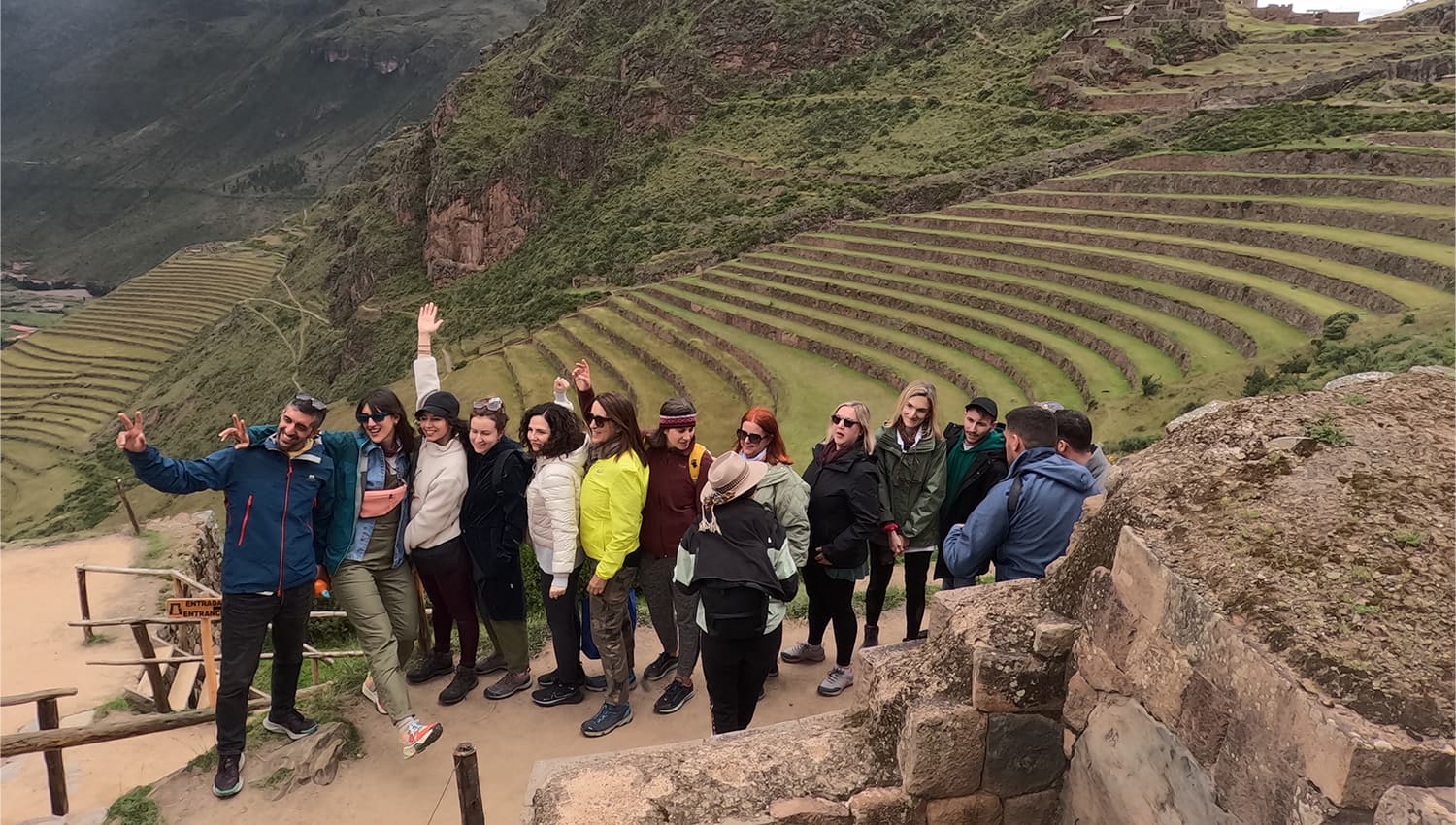-
Contact Numbers +51 961 940 225
-
Contact us hikingtrailsperu@gmail.com
- Enquire Now
Sacred Valley Tour
Full Day Tour
-
-
Group Size 12
-
Activity Level Relaxing
-
Accommodation None
-
Trip Type Day Tour
-
- Book Now
Welcome to an extraordinary journey through the heart of the Incan Empire with our Sacred Valley Tour! This immersive experience promises to transport you back in time to the ancient wonders of the Incas. From breathtaking landscapes to fascinating archaeological sites, you’ll be captivated by the rich history and cultural heritage of the Sacred Valley of the Incas.
Itinerary
Sacred Valley Tour
Our adventure starts with a prompt pick-up from your hotel lobby between 7:30 and 8:00 a.m. Your expert guide will accompany you on a scenic drive that winds around the majestic mountains north of Cusco. Along the way, we’ll make a stop at the famous El Mirador, a lookout point offering stunning views of the Sacred Valley. Take in the beauty of the landscape and gain insights into Inca history, as the Sacred Valley was one of their primary settlements, characterized by fertile plains and impressive contour terracing.
Continuing our journey, we head towards the ruins of Pisac, where you’ll step back in time and immerse yourself in Inca culture. Witness the remarkable stone art and admire the precision of the agricultural terraces that the Incas left behind. Your knowledgeable guide will provide intriguing historical context, revealing the ingenious methods and engineering prowess of the ancient civilization.
After an eventful morning, we’ll gather for a delectable lunch at a local Andean restaurant. Treat your taste buds to the flavors of traditional Peruvian cuisine, known for its diverse and mouthwatering dishes. Indulge in local delicacies as you recharge your energy for the next part of the journey.
Our tour continues along the banks of the Urubamba River towards the town of Ollantaytambo. Here, we encounter the mesmerizing ruins, an essential area of Incan construction from the height of their civilization. The site is renowned for its rock formations that represent the Inca god, Wiracocha. Stand in awe of the impressive engineering feats of the Incas, as you explore the ruins and delve into their architectural prowess.
Inclusions
Whats Included?
- Hotel Pick-up: Your journey begins with a comfortable pick-up from your hotel in Cusco, ensuring a hassle-free start to your adventure.
- Private Tourist Van: Travel in style and comfort from Cusco to the trailhead in a private tourist van, enjoying the picturesque landscapes along the way.
- Expert Guidance: Our knowledgeable, English-speaking tour guide accompanies you throughout the journey, providing fascinating insights into the history, culture, and significance of the Rainbow Mountain.
- First aid kits: We prioritize your safety with a comprehensive first aid kit, an oxygen tank, and trekking poles to ensure a secure and enjoyable trek.
- Return to Cusco: relax in the comfort of our private tourist van for the return journey from the trailhead to Cusco.
- Drop-off at Your Hotel: We conclude our tour by dropping you off at your hotel, ensuring a seamless and convenient end to your memorable adventure.
Not Included
- Meals
- Tourist Ticket : 70 Soles (if you would like to do the Sacred Valley Tour will be better to buy the full tourist ticket – 130 peruvian Soles )
Price
-
Private Service
180
-
Luxury Service
600
-
Regular Service
170
-
2 People
165
-
3 People
160
-
4 People
155
-
5 People
150
-
6 People
145
-
7 People
140
-
8 People
135
8 or more please send a email to hikingtrailsperu@gmail.com
Packing List
Packing List- Sacred Valley
- Original Passport: Always start with your passport. Ensure it’s valid for at least six months beyond your travel dates. Keep it in a safe, easily accessible place.
- Comfortable Shoes, Sneakers, or Tennis Shoes: Prioritize comfort and durability. Whether you’re walking through cobbled streets or hiking rugged trails, the right shoes can make all the difference.
- Rain Gear and Rain Ponchos: Don’t let a little rain dampen your spirits. Lightweight and compact rain gear will keep you dry and on the move.
- Long-Sleeved T-Shirts: They’re versatile – perfect for layering and protecting against the sun or chilly breezes.
- Comfortable Clothes: Opt for breathable, lightweight fabrics that are easy to wash and quick to dry.
- Sunscreen (High SPF): Protect your skin from harmful UV rays, irrespective of the weather.
- Sun Hat: Choose one with a wide brim for maximum coverage.
- Sunglasses: Not just a fashion statement, but a necessity to shield your eyes.
- Personal Medication: Don’t forget prescriptions and any over-the-counter medications you regularly use.
- Small Day Pack: Ideal for carrying essentials during day trips. Ensure it’s comfortable and durable.
- Camera and Extra Batteries: Capture memories without the fear of running out of power.
- Extra Money (Small Denominations of Peruvian Coins or American Dollars): Handy for small purchases where credit cards may not be accepted.
- Snacks: Keep energy levels up with some quick, healthy snacks.
Faqs
Undoubtedly, the Sacred Valley tour is a treasure trove of historical and natural wonders, making it unequivocally worthwhile. This journey immerses you in the heart of Incan heritage, showcasing remarkable sites like Pisac, Ollantaytambo, and Chinchero, each brimming with ancient ruins, vibrant markets, and breathtaking landscapes. The experience unveils the Incas’ architectural prowess and their harmonious relationship with nature. Moreover, interactions with local Quechua communities and glimpses into their traditions add profound cultural depth. The Sacred Valley tour is not just a journey; it’s an expedi
Yes, it’s entirely possible to explore the Sacred Valley without a guided tour. Many travelers opt for this approach to enjoy a more flexible and personalized experience. Renting a car, using public transport, or even biking are viable options. This method allows you to linger at sites like Pisac, Ollantaytambo, and Moray at your own pace, diving deep into the heart of Incan history. However, we recommend thorough planning and some knowledge of Spanish to enhance your journey. While a tour offers structured insights, self-guided exploration promises an adventure tailored to your curiosity and rhythm.
We recommend visiting the Sacred Valley before Machu Picchu. This strategic approach allows you to gradually acclimatize to the high altitude, as the Sacred Valley is lower than Cusco but higher than Machu Picchu. Exploring the Valley first not only helps in adjusting to the altitude but also enriches your understanding of Incan culture and history. By the time you reach Machu Picchu, you’ll have a deeper appreciation of its significance within the Incan civilization. This sequence ensures a more comfortable and insightful journey through these ancient wonders.
Exploring both Machu Picchu and the Sacred Valley in a single day is technically impossible . Each destination deserves ample time to fully appreciate its unique beauty and historical significance. Machu Picchu alone requires several hours to explore, while the Sacred Valley, with its rich Incan history and stunning landscapes, is best experienced at a leisurely pace. Attempting to visit both in one day would result in a rushed and potentially exhausting experience. We advise dedicating a full day to each, ensuring a more fulfilling and enriching exploration of these iconic Peruvian treasures.
While the renowned Inca Trail does not directly traverse the Sacred Valley of Cusco, it begins nearby and shares a deep connection with the region’s rich Incan heritage. The trail, primarily leading to Machu Picchu, starts at a point called the Kilometer 82. While it skirts around the Sacred Valley, hikers are still enveloped in the enchanting Andean environment that characterizes the valley. For those eager to immerse themselves in the full spectrum of Incan history, combining the Inca Trail trek with a separate visit to the Sacred Valley is highly recommended for a comprehensive experience.
Ollantaytambo is a significant, historic town within the Sacred Valley of Cusco, renowned for its well-preserved Inca ruins and unique terracing. In contrast, the Sacred Valley itself is a vast region that encompasses various towns, including Ollantaytambo, and numerous archaeological sites and landscapes. While Ollantaytambo offers a glimpse into Inca architectural ingenuity, the Sacred Valley as a whole provides a broader cultural and historical context, showcasing a diverse range of Inca sites, traditional Andean communities, and breathtaking natural beauty. Thus, Ollantaytambo is an integral part of the Sacred Valley experience but represents only one facet of this culturally rich region.
The Sacred Valley, near Cusco, holds immense significance, historically and culturally. Revered by the Incas for its fertile land and strategic location, it was a vital area for crop cultivation, symbolizing agricultural wealth and technological advancement. Today, it stands as a testament to Incan ingenuity, showcasing impressive ruins like Ollantaytambo and Pisac, and remains a living heart of Andean culture. Visitors are not only awed by its archaeological marvels but also by the enduring traditions of local communities. The Sacred Valley, therefore, is not just a historical site but a vibrant cultural journey into Peru’s past and present.
When planning a trip to the Sacred Valley and Cusco, it’s essential to consider altitude. Cusco, perched at around 3,400 meters (11,200 feet), is notably higher than the Sacred Valley. The valley, with key locations like Urubamba at about 2,870 meters (9,416 feet) and Ollantaytambo near 2,792 meters (9,160 feet), offers a slightly lower elevation. This difference often makes the Sacred Valley a preferred starting point for acclimatization before exploring the higher elevations of Cusco. Understanding this altitude variation is crucial for a comfortable and enjoyable visit to these culturally rich and historic areas.
Deciding whether to stay in Cusco or Ollantaytambo depends on your travel preferences. Cusco, a bustling city rich in history and culture, offers a wide array of restaurants, museums, and historical sites. It’s perfect for those who enjoy vibrant city life and easy access to local attractions. In contrast, Ollantaytambo, located in the heart of the Sacred Valley, provides a more tranquil setting. Its smaller scale and proximity to nature make it ideal for travelers seeking a peaceful retreat and easy access to the Sacred Valley’s archaeological sites. Consider your interests and travel
The Sacred Valley of Peru, nestled in the Andean highlands, is steeped in a rich history that dates back to the Inca Empire. Once the heartland of the Inca civilization, it was a crucial area for maize production due to its favorable climate and fertile lands. The Valley was also a key strategic and spiritual area for the Incas, evidenced by the remarkable ruins and agricultural terraces that dot its landscape. Sites like Ollantaytambo and Pisac offer glimpses into the sophisticated urban planning and architectural prowess of the Incas. The Sacred Valley’s history is a testament to the ingenuity and spirituality of this ancient civilization.
In the Sacred Valley of Cusco, a diverse array of crops flourishes, thanks to the region’s fertile soil and favorable climate. The Valley is renowned for its maize, particularly the large-kernelled variety known as choclo. Additionally, it’s a haven for potato cultivation, with numerous native varieties grown here. Quinoa, another staple, along with beans, squash, and an assortment of fruits, adds to the agricultural richness. This abundance not only reflects the Valley’s historical significance as a key Inca food source but also continues to sustain local communities and enchant visitors with its culinary diversity.
Similar tours that you may like
We are accredited by
















